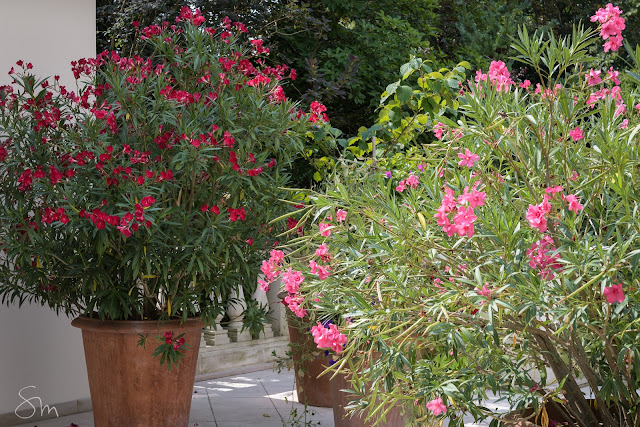This summer is an unusual one in Germany. Warm weather and sunshine for months is making us feel relaxed like on a summer vacation to Italy or Spain, no rain for weeks. This spell started at the end of April and has not left us yet. Warm days, cool nights, and for the first time in my memory, I have been leaving cushions safely outside on the patio chairs for weeks without fear of finding them soggy in the morning. We rest during the day to bake in the sun and leave all serious work for the the early mornings or possibly even autumn which will surely come.
I thought it worthwhile to take stock of the garden and see how the plants under my charge are faring. Taking a stroll through the garden with a garden hose each day though requires some nerves. Some plants cope surprisingly well, others falter even with regular watering. The few drops of rain that we had each month evaporated before they reached the soil.
My lawn looks like this - but as I was never a fan of green lawns, I don't really care and don't water it; it will surely return with the first rains.
only the little violets' leaves are still green
Luckily one red maple decided to return when I watered it extensively and is showing fresh young red leaves between the crumpled mess.
Hydrangeas are usually among the first to go. One species kept up surprisingly well though:
Hydrangea quercifolia (Oakleaf hydrangea)
Viburnum plicatum lost all its leaves; the white Euonymus fortunei next to it and the ivy behind have no problem, same with Abelia grandiflora, which is as happy as ever with its shiny leaves and scented white tiny trumpety summer blossoms.
Even my Rhododendron luteum has given in to the heat despite intensive watering
Some ferns have given up,
my beautiful Japanese Athyrium niponicum metallicum
others thrive unexpectedly:
Dryopteris purpurella
Polystichum setiferum "Plumosum Bevis" - as beautiful as ever
I was very disappointed about Heuchera. Green or purple kinds, they could not keep up and have nearly disappeared
Dwarf astilbes (A. pumila) always leave in summer except in the wettest. This year they are making at least an effort to keep up some flower spikes although most leaves are gone.
My day lily "Stella d'Oro" although supposedly sun loving found the heat or drought too much and reduced her leaves to hay.
My Echinaceas have been disapppointing as well:
While Polygonum (Bistorta) amplexicaule "Firetail" thrives without my help,
its small relative Bistorta affinis has given up.
All the roses hold out well - and so do the camellias. Whether they will flower next year remains to be seen, as the flower buds are produced in autumn.
Ghislaine de Feligonde
One little plant that I love for its striking blue colour but was always a bit unhappy in my garden is making a show now:
Ceratostigma plumbaginoides.
In recent years it sometimes failed me completely in spite of rain. It seems that it does not care about rain or sunshine, it likes hot temperatures. I love the Ceratostigmas, there is another great one called Ceratostigma willmottiana, and I hope to grow them all in my spanish garden next year.
Some Bergenias do surprisingly well, although they are supposed to be shade loving
Very disappointing are the Meconopsis cambrica that used to lighten up areas under rhododendrons and have been self-seeding freely every year - I should have recognized from their name, that Welsh Poppies don't enjoy dry heat.
Alcea has delicate leaves and flowers that look as if they would get sunburn, however she does not seem to mind neither heat nor the lack of water, another pleasant surprise.
Alcea rosea
Ophiopogon "nigrescens" enjoys the summer as well
Polygonatum verticillatum, the local variety, keeps better than the normal garden varieties
..The blue leaved hostas seem to be better able to withstand drought and heat than the green leaved cultivars.
No problems here : the small spring-flowering shrub Exochorda
The huge leaves of Macleya don't mind neither heat nor drought. Their hungry roots are very invasive and find food wherever.
Lilium martagon is settings seeds
Seeds of Paeonia mlokosewitschii
Same with all the peonies. With their tuberous roots they seem well prepared for drought.
Sun-loving Helenium (Sun's Bride)
My potted oleanders thrive like never before and fill the terrace each evening with their vanilla scent
So for the moment I continue my regular two-hour evening trip through the garden with a long hose and try to determine how much water each plants needs to give each individual what they require. It is a very unsual feeling here in Germany, of times that are changing, to be waiting for rain that we only know from different climates.
Nevertheless - this seemingly endless summer is great and we enjoy it! And if it is to be repeated, we will surely know how to cope and have installed some automatic watering system.






































